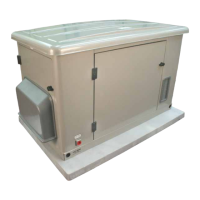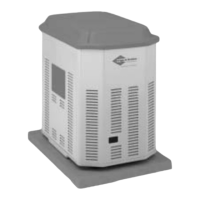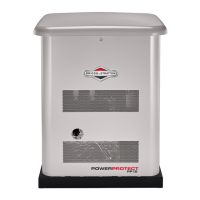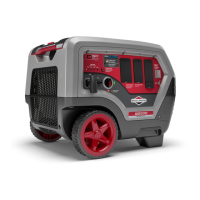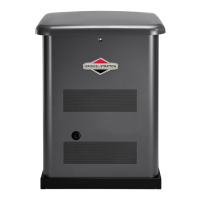20 BRIGGSandSTRATTON.com.au
Clean and inspect the spark arrester as follows:
1. Remove two screws that attaches back bumper to
muffler guard. Remove back bumper.
2. To remove muffler guard, remove two top screws
that connects guard to generator.
3. Remove screw that attaches spark arrester screen
to muffler. Remove spark arrester screen.
4. Inspect screen and obtain a replacement if torn,
perforated or otherwise damaged. DO NOT use a
defective screen. If screen is not damaged, clean
it with a brush.
5. Reattach screen to muffler. Reattach muffler guard.
Storage
The generator should be started at least once every
seven days and allowed to run at least 30 minutes. If
this cannot be done and you must store the unit for
more than 30 days, use the following guidelines to
prepare it for storage.
Generator Storage
• Clean the generator as outlined in Cleaning.
• Check that cooling air slots and openings on
generator are open and unobstructed.
Long Term Storage Instructions
Fuel can become stale when stored over 30 days.
Stale fuel causes acid and gum deposits to form in the
fuel system or on essential carburetor parts. To keep
fuel fresh, use Briggs & Stratton® Advanced Formula
Fuel Treatment & Stabilizer, available wherever Briggs
& Stratton genuine service parts are sold.
There is no need to drain gasoline from the engine
if a fuel stabilizer is added according to instructions.
Run the engine for 2 minutes to circulate the stabilizer
throughout the fuel system before storage.
If gasoline in the engine has not been treated with a
fuel stabilizer, it must be drained into an approved
container. Run the engine until it stops from lack
of fuel. The use of a fuel stabilizer in the storage
container is recommended to maintain freshness.
WARNING Exhaust heat /gases could ignite
combustibles, structures or damage
fuel tank causing a fire, resulting in
death or serious injury.
Contact with muffler area could cause burns
resulting in serious injury.
• DO NOT touch hot parts and AVOID hot exhaust gases.
• Allow equipment to cool before touching.
• Keep at least 1.5 m (5 ft) of clearance on all sides of
generator including overhead.
• Contact the original equipment manufacturer, retailer,
or dealer to obtain a spark arrester designed for the
exhaust system installed on this engine.
• Replacement parts must be the same and installed in the
same position as the original parts.
WARNING Fuel and its vapors are extremely
flammable and explosive which could
cause burns, fire or explosion
resulting in death or serious injury.
WHEN STORING FUEL OR EQUIPMENT WITH FUEL IN
TANK
• Store away from furnaces, stoves, water heaters, clothes
dryers or other appliances that have pilot light or other
ignition source because they could ignite fuel vapors.
WHEN DRAINING FUEL
• Turn generator engine OFF and let it cool at least 2
minutes before removing fuel cap. Loosen cap slowly to
relieve pressure in tank.
• Drain fuel tank outdoors.
• Keep fuel away from sparks, open flames, pilot lights,
heat, and other ignition sources.
• Check fuel lines, tank, cap and fittings frequently for
cracks or leaks. Replace if necessary.
• DO NOT light a cigarette or smoke.
